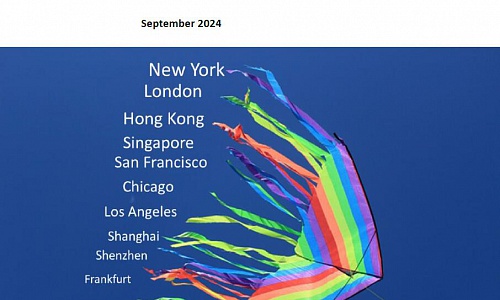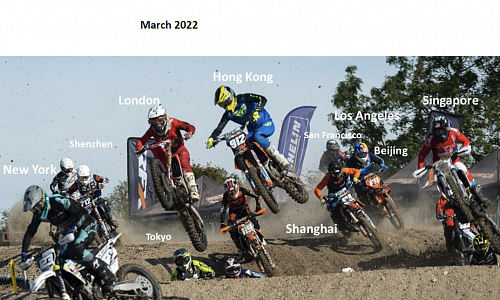Shenzhen Exemplifies Rapid Economic Rise on The Back of Tech Innovation
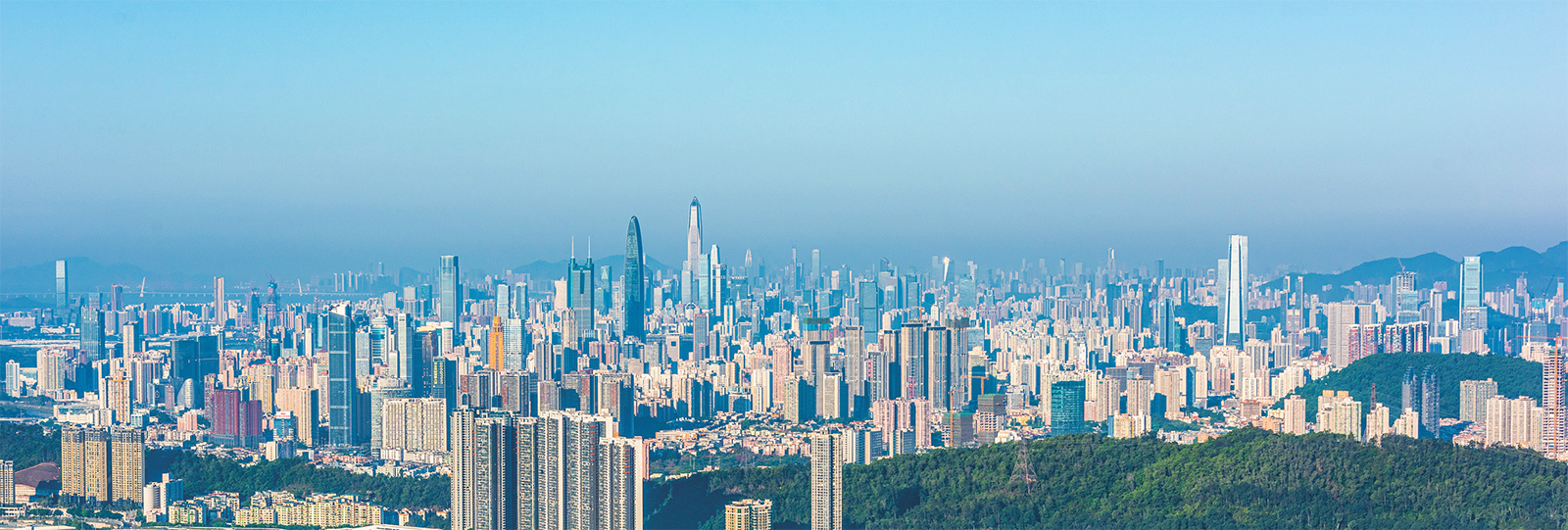
Author: Fan Gang, President of CDI and Cao Zhongxiong, Assistant President of CDI.
As a special economic zone and a city blossoming on science and technology, Shenzhen, in South China’s Guangdong Province, is not only an economic front-runner, but also a great “mirror” illustrating China’s quick pace of technology innovation and economic development.
The development of Shenzhen has been subject to questioning on many occasions in the past decades, but the city has always responded by ironing out the doubts through its rapid development in both headwinds and tailwinds.
Shenzhen represents new quality productive forces, new systems, as well as birth of new and creative policies. It is the best window to observe the transformation of China’s economic development. A more in-depth examination of Shenzhen’s economic growth can offer proof of the stable and high-quality development of China.
Shenzhen’s rapid rise demonstrates the strength of China’s ability to achieve quality breakthroughs in its economic development, reinforcing public confidence in the country’s economic creativity and capability.
Despite the challenges posed by the lackluster global economy and an increasingly complex and uncertain world environment, China’s economy managed to achieve 5.2 percent growth in 2023. During the same period, Shenzhen’s local GDP reached 3.46 trillion yuan ($480 billion), representing a 6 percent year-on-year increase, ranking first among the first-tier cities in China, outpacing the growth of Beijing, Shanghai and Guangzhou.
In 2023, Shenzhen’s strong retail sector has become a major new driving force for economic growth. Total retail sales of consumer goods reached 1.05 trillion yuan last year, an increase of 7.8 percent over 2022, officially entering the club of Chinese cities with one-trillion-yuan consumption.
From the perspective of industrial structure, Shenzhen regards the development of strategic emerging industries and the cultivation of future industries as important levers to accelerate the formation of new quality productive forces, and coordinates the construction of industrial clusters with advanced manufacturing as its backbone.
By 2023, the strategic emerging industries in Shenzhen have achieved an added value of 1.45 trillion yuan, accounting for 41.9 percent of the city’s GDP, with a year-on-year growth of 8.8 percent. In terms of the emerging industries, Shenzhen dares to make forward-looking layouts in cutting-edge technology innovation.
New technologies are broadly utilized in Shenzhen, helping form new industries in China. Shenzhen-headquartered company BGI Genomics has been leading in the global genetic technology field. Tencent, a Fortune Global 500 company, has played a significant role in promoting the development of China’s digital economy. DJI has gone from Shenzhen to the global market, promoting the development and growth of China’s drone industry.
The sustained economic growth of Shenzhen highlights the significant potential of China’s economy, reflecting the promising prospects for continued growth and ongoing improvement in China’s future development.
Innovation is the primary driving force behind Shenzhen’s rise, serving as the lifeblood of the city. Innovation is a defining characteristic of Shenzhen, playing a vital role in its development. Similarly, innovation is essential for the progress of China’s overall economy. More emphasis should be put on technological innovation on the national level, fostering new quality productive forces.
Eyeing high-quality development, Shenzhen is making great efforts to construct an industrial technology innovation center, playing the role of the leading incubator for Chinese technological advancement, and serving China’s future development.
Now, China has a number of emerging technology-heavy cities with development advantages such as Dongguan in South China’s Guangdong Province, Suzhou in East China’s Jiangsu Province, and Qingdao in East China’s Shandong Province. These cities are actively supporting technological innovation, the growth of private sector, and the cultivation of new quality productive forces, which will further stimulate the vitality and momentum of China’s development.
China’s economy is experiencing a period of steady recovery and a structural adjustment, with sufficient potential for endogenous dynamism and a large room for continued growth. As long as China focuses on solving all the problems in the course of its development, adheres to openness and high-value innovation, and continuously develops new quality productive forces, there is no reason why the Chinese economy will “peak” any time soon.
Giant Ship of China’s Economy Cruises Steadily, Defying ‘Peak’ Hype

Author: Cao Zhongxiong, Assistant President of CDI.
Despite the challenges posed by the lackluster global economy and an increasingly complex, severe, and uncertain external environment, China’s economy managed to achieve 5.2 percent growth in 2023. This growth contributed over 30 percent to global economic growth, solidifying China’s role as a crucial engine for global economic expansion. China’s economy, which is pushing over risks and challenges, has maintained steady growth in terms of quantity and scale.
In the face of multiple challenges, China successfully exceeded its annual growth target of around 5 percent set by the Government Work Report for 2023, further enhancing its status as one of the world’s top economies. In comparison with other major economies, China’s growth outpaced the 2.5 percent of the US, the 0.5 percent of the EU, and the 1.9 percent of Japan.
Economic development should not only be assessed based on quantity, but also on the quality of structural improvements. China’s high-tech industries are at the forefront of driving economic growth. In 2023, investment in technological transformation of manufacturing increased by 3.8 percent compared with the previous year, leading to a rise in the proportion of high-tech manufacturing to 15.7 percent and equipment manufacturing to 33.6 percent in the value-added industrial output.
China has maintained the fastest growth in the world ten or twenty years ago. The world has been accustomed to China’s fast growth, thinking that only fast growth is natural for China. However, it should be recognized that the Chinese economy has long surpassed the threshold of 100 trillion yuan, which is the sum of Germany, Japan, India, the UK, and Italy. Entering a new stage of high-level and high-quality development, for the 100 trillion yuan-level Chinese economy, simply observing growth rate is one-sided and biased.
Currently, the giant ship of China’s economy needs to cruise at a steady pace. Its growth rate, whether too fast or too slow, is not conducive to high-quality economic development. Issues such as insufficient consumption momentum, debt risks in the real estate sector, and hidden debts at the local level still exist.
Overall, the favorable conditions for China’s development are stronger than the unfavorable factors. The basic trend of economic recovery and improvement will not change over the long term, combined with the confidence and determination for China’s development which will remain into the future. In the current transition from old to new driving forces, stability is particularly important.
Although the current global situation is constantly changing and factors that are not conducive to globalization and economic growth are increasing, China still insists on new levels of development. This has always been China’s commitment to the world’s development.
China is actively exploring in the fields of technological innovation, development of private economy, and cultivation of new quality productive forces, which will stimulate the vitality and momentum of China’s development. The Chinese economy is in a period of steady recovery and key structural adjustment. With ample potential for continued growth, the economy is not “peaking” as Western media hyped.
To observe China’s economic growth and high-quality development, one needs to look at it with a developmental perspective. China is a super large single market, and urbanization is still in progress. China has a complete industrial chain and supply chain system, and has crossed the critical point of mid-term industrialization development. Looking across the world, there are hardly any other major countries that simultaneously meet these features. In this sense, for a considerable period of time in the future, China’s crucial role in the world economy will not be replaced.
New Zealand Ambassador to China H.E. Grahame Morton Visited CDI
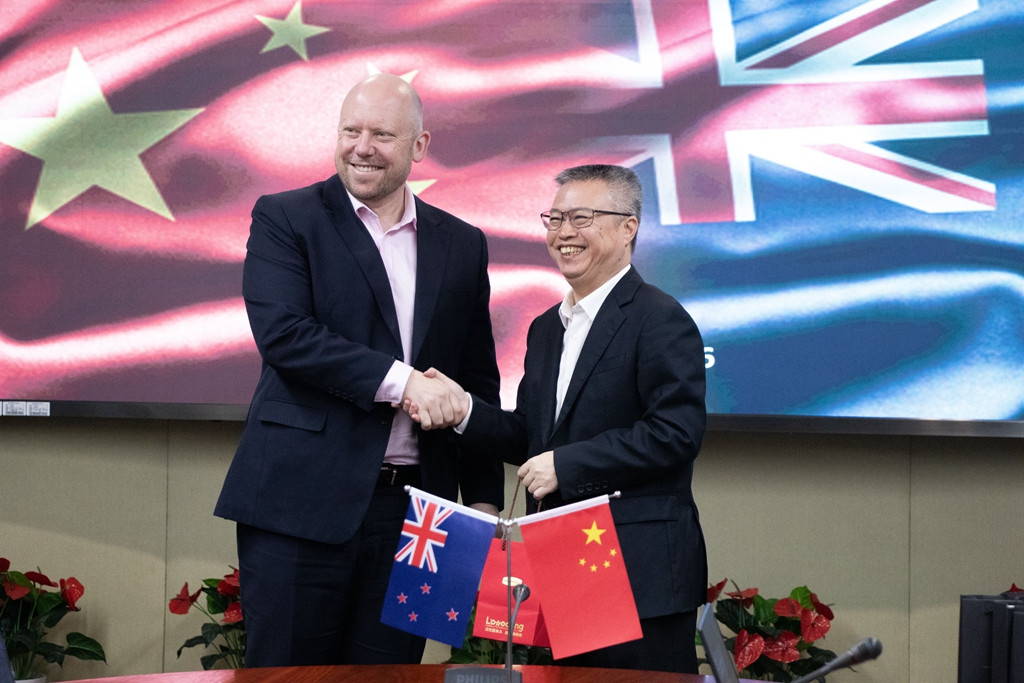
Date: Mar 26, 2024
On March 26, 2024, New Zealand delegation led by H.E. Ambassador Grahame Morton visited CDI. The visit sparked in-depth discussions on various topics, including economic policies concerning the Guangdong-Hong Kong-Macao Greater Bay Area (GBA), development progress of the GBA, and cross border industrial cooperation within the GBA. CDI experts introduced the latest trends of Hong Kong-Shenzhen Innovation and Technology Park (HSITP) located in the Lok Mak Chou Loop sitting on the Hong Kong-Shenzhen border. With preferential policy incentives in place, the HSITP will greatly facilitate the cross-border flow of production resources including capitals, talents and data. In the meanwhile, Shenzhen is becoming the forefront of reform and opening-up with the digital upgrading of traditional industries and the expansion of emerging industries. Both sides agree that China and New Zealand should explore cooperation projects in areas such as digital economy, digital trade and artificial intelligence.
Prof. Herrmann-Pillath and GBA Experts Shared Insights on NbS and Designing BiodiverCity
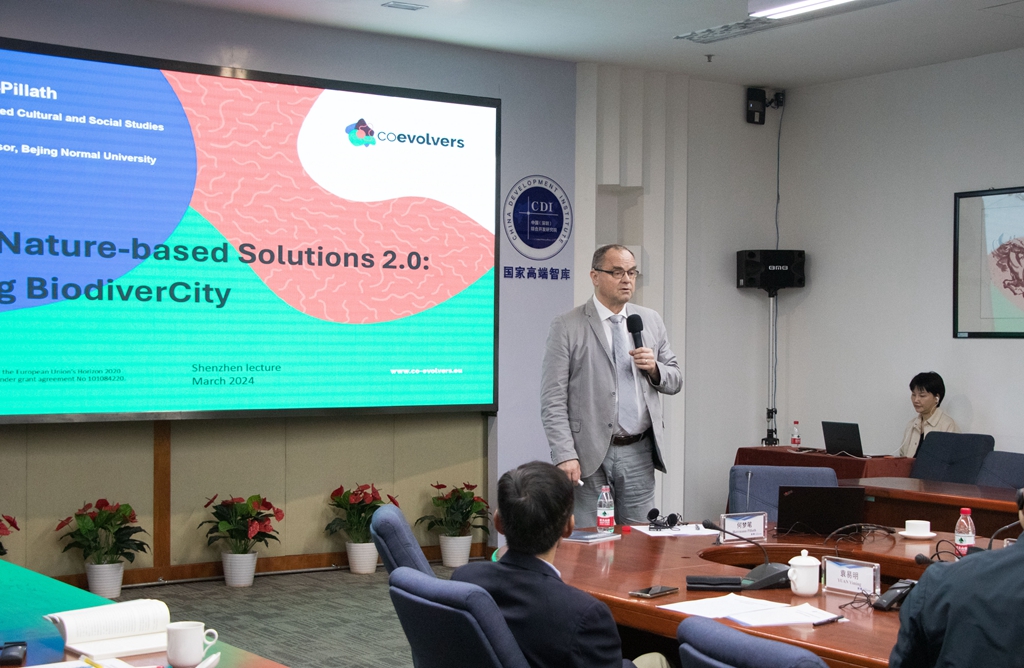
Date: Mar 19, 2024
Nature-based solutions (NbS) refers to actions that effectively address social, economic and environmental challenges through the protection, sustainable management and restoration of natural and modified ecosystems. Since the official introduction of NbS by the World Bank in 2008, it has been increasingly applied on climate action, disaster prevention, food security, water security, and ecosystem degradation.
On March 19, 2024, Prof. Dr. Carsten Herrmann-Pillath from University Erfurt was invited to share his latest research findings on NbS and designing biodivercity at CDI’s international symposium. The event was joint by role players from the public and private sectors in the Guangdong-Hong Kong-Macao Greater Bay Area. Discussion dived into how to build a co-evolutionary relationship between natural ecology and technological city to achieve more inclusive and resilient urban development.
Consul General of India to Guangzhou Mr. Shambhu Hakki Visited CDI

Date: Mar 19, 2024
On Mar 19, 2024, Consul General of India to Guangzhou Mr. Shambhu Hakki visited CDI. Discussion focused on China’s macro-economic outlook, Guangdong’s economic development, and Sino-India trade relations. Given the growing trade activities between China and India, research should be conducted to identify industrial cooperation opportunities and formulate policies and mechanisms in order to deepen the bilateral economic cooperation amid global uncertainties.
China-ASEAN Think Tank Webinar - How Can China and ASEAN Better Achieve Energy Transition
Information
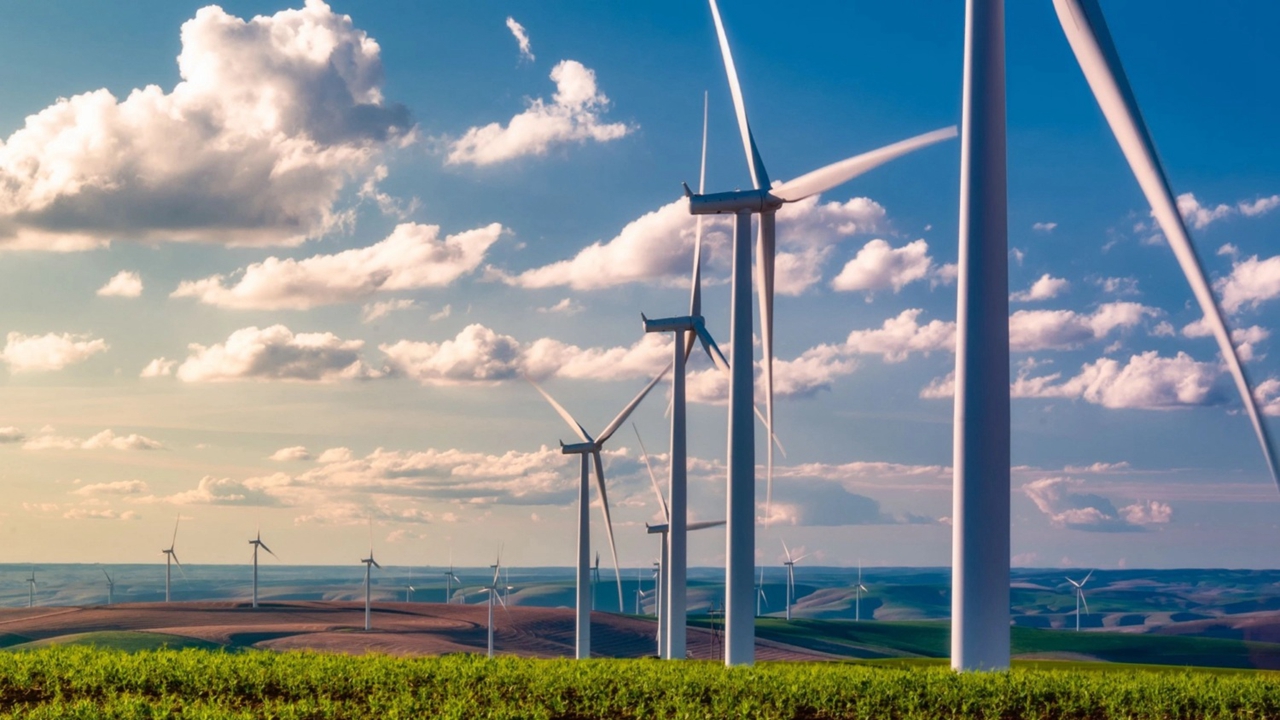
Information
Date and time: Thursday April 25, 2024 14:30-17:00 (Beijing Time, GMT+8)
Host: China Development Institute and KSI Strategic Institute for Asia Pacific
Southeast Asia is one of the world’s most economically dynamic regions. In recent years, the major energy-consuming countries within ASEAN, including Indonesia, Vietnam and Thailand, have made carbon neutral commitments and introduced a series of policies for promoting their transition to low-carbon power. As a supporter and actor of clean energy transition among developing countries, China has promoted a series of clean energy projects within the region. China and ASEAN are looking to formulate stronger policies to expand cooperation in the energy sphere, such as construction projects, experience and knowledge sharing, and the reconfiguration of electricity system.
Against such background, China Development Institute and KSI Strategic Institute for Asia Pacific will host the China-ASEAN Think Tank Webinar on 25 April 2024, bringing together experts and role players from China and ASEAN in discussion of the challenges and cooperation opportunities in energy transition.
Focus for debate:
- What are the main difficulties and potential obstacles when it comes to implementing the energy transition for both China and ASEAN countries?
- What challenges and risks still remain when China and ASEAN countries reconfigure their electricity system around renewable energy?
- In terms of regional energy cooperation, how could China and ASEAN countries complement and reinforce each other in areas such as clean energy development, regional renewable energy supply chain, and electricity trading?
*Available in English and Chinese.
Register in advance for this webinar.
After registering, you will receive a confirmation email containing information about joining the webinar.
https://us06web.zoom.us/meeting/register/tZMlde-pqzwsHNc1iP0FW2907P9cxajjMISL
Equine Industry Cooperation Between Guangzhou and Hong Kong - A Case Study of Institutional Innovation in the Guangdong–Hong Kong–Macao Greater Bay Area

Date: Dec 7, 2023
Authors: XIE Laifeng1, TAN Huifang2, ZHUANG Zhuohao3, and MO Dilang3
Due to the unique “One Country, Two Systems” framework, institutional innovation that facilitates the free flow of production factors strengthens inter-governmental cooperation and promotes the cooperative development of the economy and industries has become key to advancing the construction of the Guangdong–Hong Kong–Macao Greater Bay Area (GBA). Within the GBA, Guangzhou and Hong Kong’s success in cross-border equine industry cooperation has been empowered by the two cities’ continuous exploration of institutional innovation. This article systematically examines their experiences and presents policy improvement suggestions based on the future development needs of the cross-border equine industry.
In support of the equestrian events of the Guangzhou 2010 Asian Games, the construction of the equestrian venue and the establishment of the country’s first equine disease-free zone (EDFZ), which was certified by the World Organisation for Animal Health and the European Union, was completed in Conghua District, Guangzhou. Following the Asian Games, to maximize the usage of existing resources and facilities, the Guangzhou municipal government introduced the Hong Kong Jockey Club (HKJC) to Conghua, which later converted the equestrian venue into the Conghua Racecourse. In August 2018, The HKJC Conghua Racecourse officially opened for operation, becoming Mainland's first racecourse and thoroughbred horse training center to meet international standards. As the equine industry cooperation between Guangzhou and Hong Kong deepened, the two cities signed the Co-operation Agreement between Guangdong and Hong Kong on Equine Industry Development in May 2021, and since have steadily advanced major projects such as an international horse-trading platform and international equestrian sports events.
After examining the cooperation process within the Guangzhou–Hong Kong equine industry, it became evident that amidst the development of the GBA, some of the regulatory measures presented challenges that hindered the cross-border flow of production factors between Hong Kong and the Mainland which was fundamental for further industrial development. Therefore, governmental-level institutional innovation became imperative. The institutional innovation in the Guangdong–Hong Kong equine industry cooperation is illustrated in the following four areas.
First, regarding government cooperation mechanisms, designated task force and leadership groups were created. The Guangdong–Hong Kong Equine Industry Cooperation Task Force, established under the Hong Kong/Guangdong Co-operation Joint Conference mechanism, can collaboratively plan the coordinated development of the equine industry in the GBA at a higher level and serve as an important medium in addressing challenges that emerged during the development process in a targeted manner. Additionally, the task force promotes exchanges among relevant enterprises, institutions, and personnel between the two locations. Guided by the task force, Guangzhou and Conghua have each established leadership groups for the equine industry, collaboratively advancing the implementation of various initiatives for the development of the Guangzhou–Hong Kong equine industry.
Second, in terms of customs clearance, the introduction of the “one-time approval, multiple round trips” registration and filing system, which allows horses multiple entries and exits to Guangzhou during a validity period, has created a new model for cross-border horse transportation within the GBA. Furthermore, the exchange of horses between the two locations is safeguarded by the establishment of unified inspection standards and a recognition mechanism for inspection and quarantine testing results. Lastly, Guangzhou Customs has established a dedicated office at the Conghua Racecourse to implement biosecurity surveillance and controls to guarantee the security of the EDFZ and cross-border horse transportation.
Third, the collaborative effort of Hong Kong’s Agriculture, Fisheries and Conservation Department and mainland authorities, including Customs, Ministry of Agriculture and Rural Affairs, and provincial, municipal, and district governments, was fundamental to the pioneering establishment of an EDFZ that spans the entire Conghua District and the innovative inclusion of a biosafety highway that enables the direct transfer of horses between Conghua and Hong Kong.
Fourth, the Guangzhou municipal government has delegated foreigner visa issuance to Conghua, allowing foreign employees of HKJC to apply for visas nearby. With the assistance of the Guangzhou Municipality, the children of non-Guangzhou Hukou talents employed by the HKJC who meet the prescribed conditions can enroll with their nearest compulsory education provider without taking entrance exams.
The equine industry cooperation between Guangzhou and Hong Kong has yielded fruitful results; however, to maximize cooperation in the cross-border equine industry chain, both Guangzhou and Hong Kong must continue to explore more substantial institutional innovations.
Firstly, increased facilitation to smooth the movement of horses and clearance of associated goods is needed. Examples include streamlining the clearance process, establishing a normalized emergency response mechanism, and establishing dedicated control stations at both the origin and destination points of cross-border horse transportation routes.
Secondly, to facilitate the international horse-trading platform and international equestrian events, proactive policy arrangements should be made so registered foreign veterinarians can provide veterinary services in Guangzhou and Conghua.
Thirdly, further research into creating a mechanism that promotes international mutual recognition of inspection and quarantine findings is needed to allow foreign horses to transit the Conghua EDFZ which is critical for hosting international equestrian events.
Lastly, introducing and nurturing talent in the equine industry is vital. It is recommended that to strengthen talent training in the equine industry further, support be provided to relevant universities to build faculties focused on the modern equine industry. Additionally, the facilitation of HKJC’s foreign employees working and living in Guangzhou should be continued, professional qualifications recognition be supported, and industry professionals be enabled to enjoy preferential personal income tax policies within the GBA.
---------------------------
- Deputy Director, Department of Hong Kong, Macao and Regional Development, CDI
- Lecturer, School of Economics and Management, Xiangnan University
- Project Research Fellow, Department of Hong Kong, Macao and Regional Development, CDI
Shenzhen Racing into the Era of Artificial Intelligence

Date: August 21, 2023
Author: Dr. LI Enhan and Ms. ZHUO Shengling, China Token Digital Economic Research Center, CDI
When discussing the rapid advancement of artificial intelligence, it undoubtedly marks the dawn of a new era in technology. It is set to become a key force driving a new wave of technological revolution and industrial transformation. Shenzhen has released a corresponding action plan and the initial roster of "City + AI" application scenarios, while also establishing a substantial 100 billion CNY fund dedicated to artificial intelligence.
Overview of the global competition in artificial intelligence
On a global scale, the competition in artificial intelligence has become a pivotal area where countries vie for dominance. Leading technological powers like the United States, the European Union, and China continue to intensify their investments and strategic positioning in the AI domain.
The United States stands out for its strategic leadership, substantial capital support, and technological edge. Consistently investing in policies and research in AI, it aims to retain its global leadership. In recent years, the U.S. has introduced a series of significant policy documents, emphasizing funding particularly in technological applications in national defense.
The European Union prioritizes safeguarding fundamental rights and leads the way in establishing regulatory frameworks for artificial intelligence. Its focus lies in preventing technological development from potential erosion of human rights, exploring the establishment of a regulatory system, and ensuring the safety of artificial intelligence technology and applications within the EU. Additionally, Europe holds significant advantages in applying AI technology to manufacturing and industrial automation.
With abundant data resources, robust technological foundations, and strong policy support, China's AI industry thrives, unveiling innovative application scenarios continuously. China has also shifted its policy focus from industrial development towards technological regulation and governance, emphasizing the balance between technological oversight and industrial growth. Moreover, it actively publishes ethical guidelines and policy documents to ensure that the advancement of artificial intelligence does not compromise national security or societal order.
The development of the artificial intelligence industry in China’s major cities
Major cities in China are actively exploring various initiatives to become leaders in global AI development, each following its unique development path.
Beijing, leveraging its vast talent pool, outstanding technical prowess, and innovative atmosphere, has issued multiple policies to encourage the development of the AI industry, striving to build itself as an innovation hub for AI.
Shanghai, with a primary advantage in application-driven innovation, extensively applies AI technology across economic, societal, and governance domains within its digital transformation efforts, and strives to create an artificial intelligence “Shanghai hub”.
Shenzhen aims to become a significant player in the global AI arena. The city government has introduced numerous policies and plans while establishing a 100 billion CNY AI fund to foster a comprehensive development environment. Supported by the electronics and information industry, Shenzhen focuses on breakthroughs in core technologies, accelerating the introduction and development of key industries, and attracting numerous enterprises to enter various levels of the artificial intelligence industrial chain.
Next steps for Shenzhen
Shenzhen's future in AI development will center around three core directions. Firstly, there's a push for a deeper integration of artificial intelligence technology with the real economy, especially the industrial manufacturing. This involves adhering to the objective laws of technological development and steering clear of excessive exaggeration or speculative practices. The focus should be on strengthening collaborative innovation between foundational research and industrial applications. Additionally, there's a drive to integrate AI technology with infrastructure construction. It's vital to leverage industrial funds as well, ensuring continuous updates and iterations to expedite technological maturity.
Secondly, effectively leveraging both market initiative and government guidance is critical. Shenzhen's market-oriented environment, exceptional business atmosphere, and favorable policies are vital to spark innovation among market entities in artificial intelligence. At the market level, it is imperative to give full play of the advantages brought by major enterprises and platforms in terms of technology, data, and integrated ecosystems. Regarding the government’s role, there should be continual increments in investments in new infrastructure, orderly progression in open sharing of public data, and exploration of cross-border data circulation between Shenzhen and Hong Kong.
Ultimately, the crux of advancing artificial intelligence lies in finding a balance between innovation and security. This entails ensuring the safety and sustainability of AI innovation through three primary aspects: rigorous compliance with pertinent legal regulations, emphasis on integrated development, and exploration of ethical standards alongside policy frameworks.
Rachel Crump, Consul-General of New Zealand in Guangzhou Visited CDI
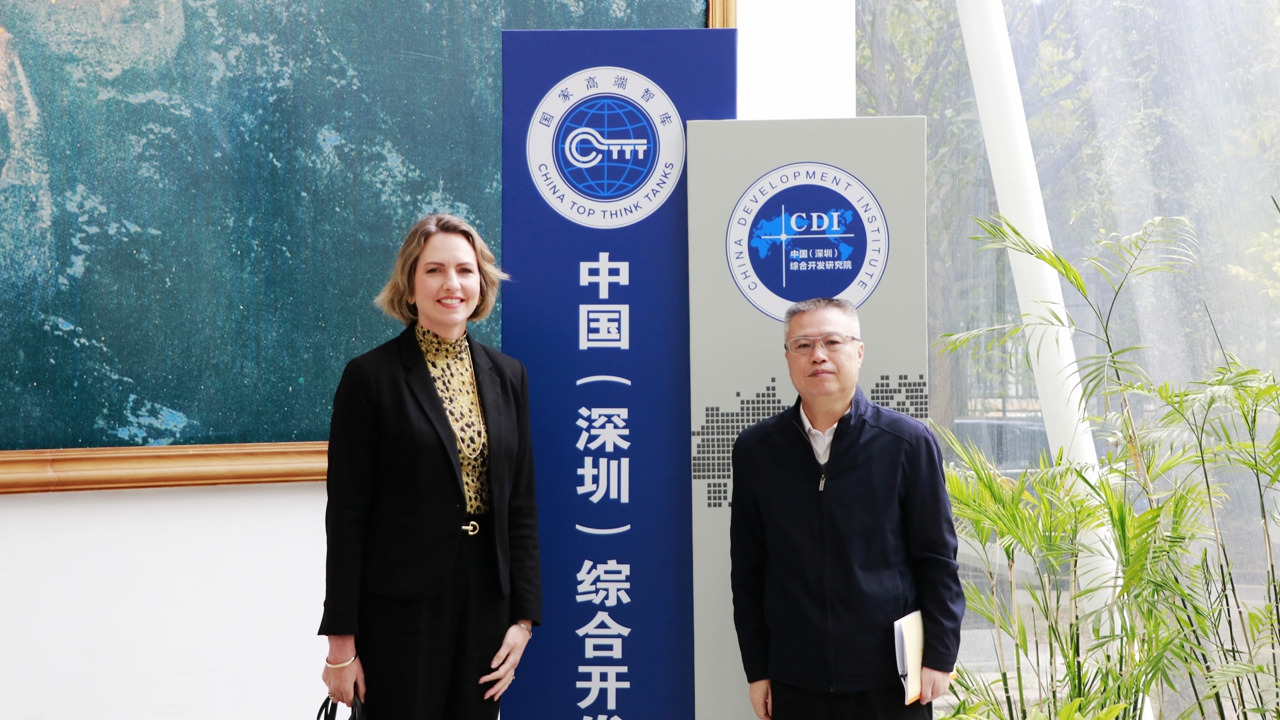
Date: Feb 27, 2024
Consul-General of New Zealand in Guangzhou Ms. Rachel Crump visited CDI on February 27, 2024. Discussion surrounded topics such as New Zealand and Guangdong’s trade relation, Shenzhen’s economic development, and the trends of electric vehicles in China. Dr. Guo Wanda, Executive Vice President of CDI, provided an overview of BYD’s development since its establishment in Shenzhen in 1995. With the strong economic and trade ties between New Zealand and China, both sides agree to explore and expand the scope of cooperation in such areas of digital economy, digital trade, and green energy in the future.
Professor Fan Gang Met with Financial Secretary Paul Chan Mo-po of Hong Kong

Date: Jan 31, 2024
From 21st to 26th Jan 2024, Prof. Fan Gang, President of China Development Institute, was invited by the Government of Hong Kong Special Administrative Region to visit Hong Kong and conduct in-depth exchange with government officials, including Financial Secretary Mr. Paul Chan Mo-po and President of the Legislative Council Mr. Andrew Leung, and various HKSAR departments discussing Hong Kong’s latest trends of political, economic and social developments.
Although Hong Kong was faced with external challenges, its economy saw steady growth in 2023. Stable increase of net fund inflow into the stock market and expansion of the scale of asset and wealth management showed that investor’s confidence in Hong Kong international financial center remained strong. Looking forward, Hong Kong will continue to strengthen its ties with the international market, further integrate within the Guangdong-Hong Kong-Macao Greater Bay Area, while transforming itself into a hub for innovation and technology development.
During his visit, Prof. Fan attended the Asian Financial Forum and chaired the panel discussion on “Stewarding China’s New Chapter”.



